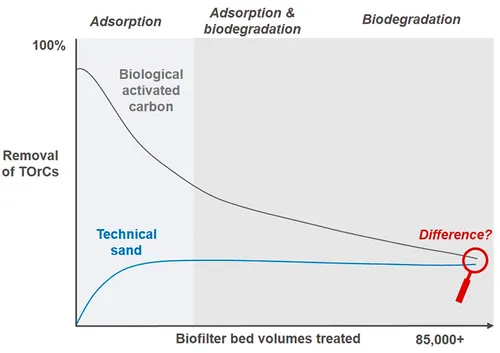Removal of trace organic chemicals (TOrCs) at environmentally relevant concentrations was investigated in technical sand and biological activated carbon (BAC) biofilters processing nearly 90000 bed volumes. This long time period allowed assessment of potential synergies from the interplay of adsorption, desorption, and biodegradation after full breakthrough. Long-term operation of the biofilters continuously fed with real wastewater effluent mimicked field conditions and consequentially encountered numerous mechanical and chemical issues. However, results of high-resolution sampling during which the system was fed from a single batch of tertiary effluent revealed compound-specific removal patterns. Comparison of persistent compounds like carbamazepine, primidone, and tramadol suggested that removal by adsorption onto activated carbon was still occurring after almost 90000 bed volumes had been treated. No notable difference in biodegradation could be observed between sand and BAC. The results from a subsequent batch biodegradation test mostly confirmed the conclusions about removal from high-resolution sampling. Overall, this study could not provide evidence that usage of activated carbon as a biofilter medium is beneficial for long-term removal after full breakthrough of individual TOrC adsorption capacity.
Zhiteneva et al. 2020
Neuer Zeitschriftenbeitrag von Zhiteneva et al. 2020
